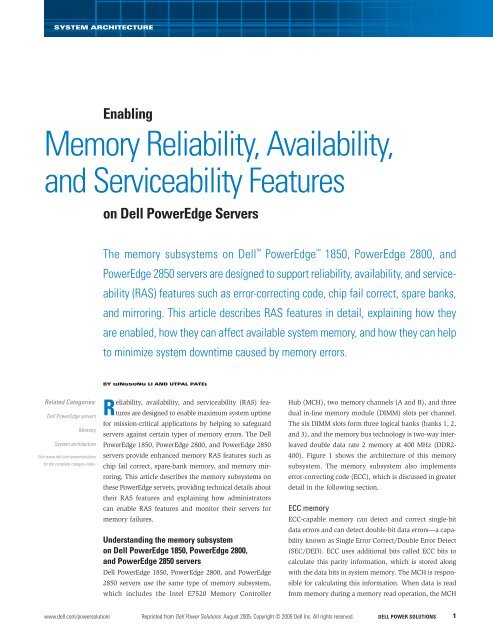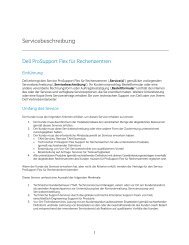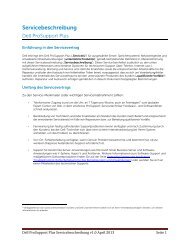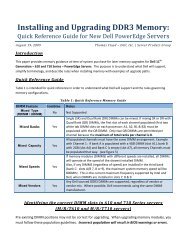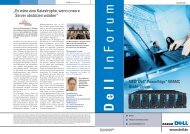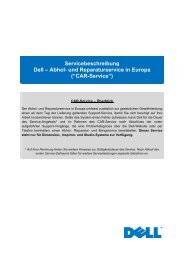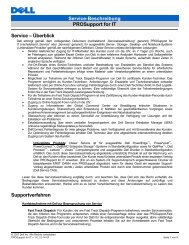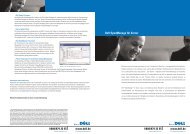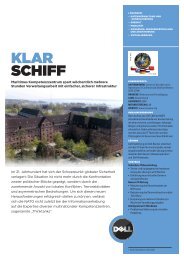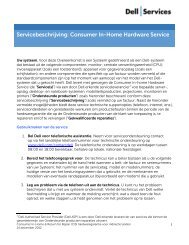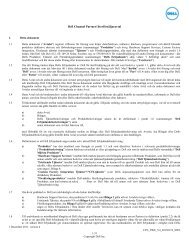Memory Reliability, Availability, and Serviceability Features - Dell
Memory Reliability, Availability, and Serviceability Features - Dell
Memory Reliability, Availability, and Serviceability Features - Dell
You also want an ePaper? Increase the reach of your titles
YUMPU automatically turns print PDFs into web optimized ePapers that Google loves.
SYSTEM ARCHITECTURE<br />
Enabling<br />
<strong>Memory</strong> <strong>Reliability</strong>, <strong>Availability</strong>,<br />
<strong>and</strong> <strong>Serviceability</strong> <strong>Features</strong><br />
Related Categories:<br />
<strong>Dell</strong> PowerEdge servers<br />
<strong>Memory</strong><br />
System architecture<br />
Visit www.dell.com/powersolutions<br />
for the complete category index.<br />
on <strong>Dell</strong> PowerEdge Servers<br />
The memory subsystems on <strong>Dell</strong> PowerEdge 1850, PowerEdge 2800, <strong>and</strong><br />
PowerEdge 2850 servers are designed to support reliability, availability, <strong>and</strong> serviceability<br />
(RAS) features such as error-correcting code, chip fail correct, spare banks,<br />
<strong>and</strong> mirroring. This article describes RAS features in detail, explaining how they<br />
are enabled, how they can affect available system memory, <strong>and</strong> how they can help<br />
to minimize system downtime caused by memory errors.<br />
BY QINGSONG LI AND UTPAL PATEL<br />
<strong>Reliability</strong>, availability, <strong>and</strong> serviceability (RAS) features<br />
are designed to enable maximum system uptime<br />
for mission-critical applications by helping to safeguard<br />
servers against certain types of memory errors. The <strong>Dell</strong><br />
PowerEdge 1850, PowerEdge 2800, <strong>and</strong> PowerEdge 2850<br />
servers provide enhanced memory RAS features such as<br />
chip fail correct, spare-bank memory, <strong>and</strong> memory mirroring.<br />
This article describes the memory subsystems on<br />
these PowerEdge servers, providing technical details about<br />
their RAS features <strong>and</strong> explaining how administrators<br />
can enable RAS features <strong>and</strong> monitor their servers for<br />
memory failures.<br />
Underst<strong>and</strong>ing the memory subsystem<br />
on <strong>Dell</strong> PowerEdge 1850, PowerEdge 2800,<br />
<strong>and</strong> PowerEdge 2850 servers<br />
<strong>Dell</strong> PowerEdge 1850, PowerEdge 2800, <strong>and</strong> PowerEdge<br />
2850 servers use the same type of memory subsystem,<br />
which includes the Intel E7520 <strong>Memory</strong> Controller<br />
Hub (MCH), two memory channels (A <strong>and</strong> B), <strong>and</strong> three<br />
dual in-line memory module (DIMM) slots per channel.<br />
The six DIMM slots form three logical banks (banks 1, 2,<br />
<strong>and</strong> 3), <strong>and</strong> the memory bus technology is two-way interleaved<br />
double data rate 2 memory at 400 MHz (DDR2-<br />
400). Figure 1 shows the architecture of this memory<br />
subsystem. The memory subsystem also implements<br />
error-correcting code (ECC), which is discussed in greater<br />
detail in the following section.<br />
ECC memory<br />
ECC-capable memory can detect <strong>and</strong> correct single-bit<br />
data errors <strong>and</strong> can detect double-bit data errors—a capability<br />
known as Single Error Correct/Double Error Detect<br />
(SEC/DED). ECC uses additional bits called ECC bits to<br />
calculate this parity information, which is stored along<br />
with the data bits in system memory. The MCH is responsible<br />
for calculating this information. When data is read<br />
from memory during a memory read operation, the MCH<br />
www.dell.com/powersolutions Reprinted from <strong>Dell</strong> Power Solutions, August 2005. Copyright © 2005 <strong>Dell</strong> Inc. All rights reserved. DELL POWER SOLUTIONS 1
SYSTEM ARCHITECTURE<br />
2<br />
CPU<br />
0<br />
<strong>Memory</strong><br />
Controller<br />
Hub<br />
computes the new parity <strong>and</strong> compares it with the stored parity. If<br />
there is a mismatch, then a mechanism within the MCH detects the<br />
faulty bit. The faulty bit is “flipped” from “1” to “0” or from “0”<br />
to “1” <strong>and</strong> returned to the host. The error is then reported in the<br />
systems management logs. If a multibit error occurs, it is detected<br />
<strong>and</strong> logged but not corrected.<br />
The memory subsystem on PowerEdge 1850, PowerEdge 2800,<br />
<strong>and</strong> PowerEdge 2850 servers implements st<strong>and</strong>ard ECC. The memory<br />
bus has 64 data lines <strong>and</strong> eight ECC lines.<br />
Minimizing memory errors with RAS features<br />
<strong>Memory</strong> errors are characterized as either soft or hard. Soft errors<br />
are transient <strong>and</strong> occasional; hard errors are permanent <strong>and</strong> are<br />
found in the silicon or in metallization of the dynamic RAM (DRAM)<br />
packaging. Regardless of the type of error, the number of data bits<br />
in error determines the system behavior. Single-bit errors are usually<br />
correctable in an ECC memory system. Multibit errors may be fatal<br />
if a system cannot recover from them.<br />
The following sections describe the RAS features available in<br />
PowerEdge 1850, PowerEdge 2800, <strong>and</strong> PowerEdge 2850 servers<br />
<strong>and</strong> how they can help minimize memory errors. Chip fail cor-<br />
rect helps overcome one class of<br />
multibit errors. Spare-bank memory<br />
<strong>and</strong> memory mirroring are other<br />
advanced mechanisms that enable<br />
systems to h<strong>and</strong>le memory errors.<br />
Chip fail correct<br />
CPU<br />
1<br />
800 MHz<br />
frontside bus<br />
(6.4 GB/sec)<br />
DDR2-400<br />
channel A<br />
(3.2 GB/sec)<br />
Figure 1. <strong>Memory</strong> subsystem on PowerEdge 1850, PowerEdge 2800, <strong>and</strong><br />
PowerEdge 2850 servers<br />
A DIMM has multiple identical DRAM<br />
devices. Each DRAM device on a DIMM<br />
can have 4 or 8 data lines. The cor-<br />
responding DIMM is called a x4 or x8<br />
DIMM 3 A<br />
DIMM 2 A<br />
DDR2-400 channel B<br />
(3.2 GB/sec)<br />
DIMM 1 A<br />
DIMM 3 B<br />
DIMM 2 B<br />
DIMM 1 B<br />
DIMM, respectively. In a x4 ECC DIMM, 18 DRAM devices are<br />
needed to form the width of the memory bus (18×4 = 72 bits<br />
[64 data bits <strong>and</strong> 8 ECC bits]). These 18 DRAM devices form a<br />
rank. Similarly, for a x8 single-rank DIMM, nine DRAM devices<br />
are needed. The PowerEdge 1850, PowerEdge 2800, <strong>and</strong> PowerEdge<br />
2850 servers support single-rank as well as dual-rank DIMMs. A<br />
maximum of four ranks are supported per memory channel.<br />
Chip fail correct enables a system to withst<strong>and</strong> a multibit error<br />
within a DRAM device on a DIMM. On the PowerEdge 1850, PowerEdge<br />
2800, <strong>and</strong> PowerEdge 2850<br />
servers, chip fail correct is<br />
fully supported on x4 DIMMs<br />
<strong>and</strong> partially supported on x8<br />
DIMMs. On x4 DIMMs, chip<br />
fail correct can rectify the error<br />
when all the bits of a DRAM<br />
are in error; on x8 DIMMs, this<br />
feature works only when up to<br />
four data lines are in error. In<br />
chip fail correct, every bit of<br />
a DRAM is part of a separate<br />
ECC word. An ECC word con-<br />
sists of data bits <strong>and</strong> ECC bits.<br />
The ECC bits are computed for<br />
each ECC word <strong>and</strong> stored. If<br />
multiple bits of a DRAM are in<br />
error, then all the bits can be corrected by the ECC algorithm because<br />
the chip fail correct feature recognizes them as a single-bit error for<br />
each ECC word.<br />
On the PowerEdge 1850, PowerEdge 2800, <strong>and</strong> PowerEdge 2850<br />
servers, in two-channel interleaved mode, the 144 bits are divided<br />
into four 36-bit ECC words, as shown in Figure 2. The BIOS enables<br />
the chip fail correct feature in the MCH when it detects x4 DIMMs<br />
installed.<br />
Spare-bank memory<br />
The spare-bank memory feature is implemented in the MCH <strong>and</strong> the<br />
system BIOS, enabling administrators to configure a spare row, or<br />
DRAM 0 DRAM 1 DRAM 17 DRAM 0 DRAM 1 DRAM 17<br />
36-bit<br />
ECC word<br />
36-bit<br />
ECC word<br />
Figure 2. Bits divided into ECC words in two-channel interleaved mode<br />
36-bit<br />
ECC word<br />
The PowerEdge 1850,<br />
PowerEdge 2800, <strong>and</strong><br />
PowerEdge 2850 servers<br />
include memory RAS<br />
capabilities that are designed<br />
to help minimize system<br />
downtime caused by<br />
memory failures.<br />
36-bit<br />
ECC word<br />
DELL POWER SOLUTIONS Reprinted from <strong>Dell</strong> Power Solutions, August 2005. Copyright © 2005 <strong>Dell</strong> Inc. All rights reserved. August 2005
ank, of memory. This feature is available on the PowerEdge 1850,<br />
PowerEdge 2800, <strong>and</strong> PowerEdge 2850 servers only when all three<br />
banks of memory are populated with identical DIMMs. Administra-<br />
tors can configure this feature in the system BIOS setup (by press-<br />
ing F2 to access the BIOS settings). The BIOS detects the memory<br />
configuration during the power-on self-test (POST) <strong>and</strong> provides the<br />
administrator with the option to enable this feature.<br />
When this feature is enabled, only banks 1 <strong>and</strong> 2 are avail-<br />
able to the administrator—as the spare, bank 3 is not in use. If<br />
the number of correctable errors that occur within a certain time<br />
frame on a particular DIMM in either bank 1 or bank 2 exceeds a<br />
threshold set in the BIOS, the BIOS will instruct the MCH to copy all<br />
data from the failing bank to bank 3 <strong>and</strong> to remap the memory in<br />
the system. After the copy process has completed, the failing bank<br />
is no longer used. The system uses bank 3 instead.<br />
The impact of this feature is that one-third of the installed<br />
memory is not available to the system at any one time. In return,<br />
the system can benefit from an intelligent memory fault-tolerance<br />
mechanism that enables recovery from a large number of continu-<br />
ous correctable memory errors.<br />
<strong>Memory</strong> mirroring<br />
Like spare-bank memory, memory mirroring is implemented in the<br />
MCH <strong>and</strong> the system BIOS. Administrators can configure the system<br />
to maintain a mirrored copy of the data in memory, similar to RAID-1<br />
in storage technology. On the PowerEdge 1850, PowerEdge 2800, <strong>and</strong><br />
PowerEdge 2850 servers, this feature is available only when banks<br />
1 <strong>and</strong> 2 are populated with identical DIMMs—<strong>and</strong> bank 3 must be<br />
empty. This feature is configurable in the system BIOS setup.<br />
When an administrator enables this feature, banks 1 <strong>and</strong> 2<br />
are configured as mirrored copies of each other. One bank is the<br />
primary copy while the other bank is the secondary copy. When<br />
data is written to memory, it is written to both banks. However,<br />
on a memory read, data is read back from the primary copy. If an<br />
uncorrectable error is detected on the read operation, the BIOS<br />
switches the primary <strong>and</strong> secondary banks. The system then reads<br />
from the new primary bank. A lost memory redundancy event is<br />
logged in the system event log (SEL).<br />
The impact of this feature is that half of the installed memory<br />
is not available to the system at any one time. In return, the system<br />
can benefit from protection against uncorrectable memory errors<br />
that might otherwise result in unexpected system downtime <strong>and</strong><br />
possibly data loss.<br />
Enabling RAS features in <strong>Dell</strong> PowerEdge servers<br />
Although chip fail correct is automatically enabled by the BIOS<br />
in the MCH, spare-bank memory <strong>and</strong> memory mirroring features<br />
must be configured by the administrator. Spare-bank memory<br />
<strong>and</strong> memory mirroring features are mutually exclusive; administrators<br />
SYSTEM ARCHITECTURE<br />
Figure 3. BIOS setup screen showing that spare-bank memory is enabled<br />
Figure 4. BIOS setup screen showing that memory mirroring is enabled<br />
can enable one or the other, but not both at the same time.<br />
Furthermore, these two features are available to administrators<br />
in the BIOS setup only if the supported memory configurations<br />
are installed.<br />
When configuring spare-bank memory <strong>and</strong> memory mirroring<br />
features, administrators should press F2 to enter the system BIOS<br />
setup. The memory setting is listed under “Redundant <strong>Memory</strong>” on<br />
the BIOS setup screen, as shown in Figures 3 <strong>and</strong> 4.<br />
Monitoring memory events<br />
The BIOS logs memory error, spare-bank memory, <strong>and</strong> mirroring<br />
events in the SEL in the baseboard management controller (BMC).<br />
Administrators can view the SEL through <strong>Dell</strong> OpenManage <br />
Server Administrator or the Web-based graphical user interface<br />
of the <strong>Dell</strong> Remote Access Controller (DRAC). Figure 5 shows the<br />
www.dell.com/powersolutions Reprinted from <strong>Dell</strong> Power Solutions, August 2005. Copyright © 2005 <strong>Dell</strong> Inc. All rights reserved. DELL POWER SOLUTIONS 3
SYSTEM ARCHITECTURE<br />
SEL when accessed through the DRAC. Administrators can then<br />
perform a scheduled shutdown, replace faulty DIMMs, <strong>and</strong> get<br />
systems up <strong>and</strong> running.<br />
Enhancing memory reliability <strong>and</strong> system availability<br />
The PowerEdge 1850, PowerEdge 2800, <strong>and</strong> PowerEdge 2850 servers<br />
include memory RAS capabilities that are designed to help minimize<br />
system downtime caused by memory failures. Administrators can<br />
easily enable these features <strong>and</strong> then monitor memory failure events<br />
4<br />
by viewing system logs. By equipping PowerEdge servers with fault-<br />
tolerant memory capabilities, <strong>Dell</strong> helps data center administrators<br />
enhance reliability <strong>and</strong> availability of business-critical systems.<br />
References<br />
Locklear, David. “Chipkill Correct <strong>Memory</strong> Architecture.”<br />
<strong>Dell</strong> Enterprise Systems Group technology brief, August 2000.<br />
www.ece.umd.edu/courses/enee759h.S2003/references/<br />
chipkill.pdf.<br />
Qingsong Li is a product development engineer in the <strong>Dell</strong> Enterprise<br />
Server Product Group. He has a B.S. in Electrical Engineering from Harbin<br />
Institute of Technology in China <strong>and</strong> an M.S. in Electrical Engineering from<br />
The Ohio State University.<br />
Utpal Patel is a test engineer in the Server Product Test Group at <strong>Dell</strong>. He<br />
has a bachelor’s degree in Computer Engineering from Mumbai University<br />
in India <strong>and</strong> an M.S. in Computer Networking from North Carolina State<br />
University.<br />
FOR MORE INFORMATION<br />
<strong>Dell</strong> PowerEdge 1850, PowerEdge 2800, <strong>and</strong> PowerEdge 2850:<br />
www.dell.com/poweredge<br />
DELL POWER SOLUTIONS Reprinted from <strong>Dell</strong> Power Solutions, August 2005. Copyright © 2005 <strong>Dell</strong> Inc. All rights reserved. August 2005


